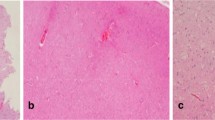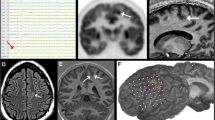Abstract
Background
Cortical dysplasia is the most common cause of pediatric refractory epilepsy. MRI detection of epileptogenic lesion is associated with good postsurgical outcome. Additional electrophysiological information is suggested to be helpful in localization of cortical dysplasia. Educational measures were taken to increase the awareness of cortical dysplasia at our institution in the context of a recent International League Against Epilepsy (ILAE 2011) classification of cortical dysplasia.
Objective
To determine changes in the rate of prospective identification of cortical dysplasia on an initial radiology report and also evaluate the benefit of MRI review as part of a multidisciplinary epilepsy conference in identifying previously overlooked MRI findings.
Materials and methods
We retrospectively evaluated surgically treated children with refractory epilepsy from 2007 to 2014 with cortical dysplasia on histopathology. We analyzed the initial radiology report, preoperative MRI interpretation at multidisciplinary epilepsy conference and subsequent retrospective MRI review with knowledge of the resection site. We recorded additional electrophysiological data and the presence of lobar concordance with the MRI findings.
Results
Of 78 children (44 MRI lesional) evaluated, 18 had initially overlooked MRI findings. Comparing 2007–2010 to 2011–2014, there was improvement in the rate of overlooked findings on the initial radiology report (54% vs. 13% of lesional cases, respectively; P = 0.008). The majority (72%) were identified at a multidisciplinary conference with lobar concordance of findings with at least one additional electrophysiological investigation in 89%.
Conclusion
Awareness of current classification schemes of cortical dysplasia and image review in the context of a multidisciplinary conference can lead to improved MRI detection of cortical dysplasia in children.





Similar content being viewed by others
References
Harvey AS, Cross JH, Shinnar S et al (2008) Defining the spectrum of international practice in pediatric epilepsy surgery patients. Epilepsia 49:146–155
Rowland NC, Englot DJ, Cage TA et al (2012) A meta-analysis of predictors of seizure freedom in the surgical management of focal cortical dysplasia. J Neurosurg 116:1035–1041
Leach JL, Miles L, Henkel DM et al (2014) Magnetic resonance imaging abnormalities in the resection region correlate with histopathological type, gliosis extent, and postoperative outcome in pediatric cortical dysplasia. J Neurosurg Pediatr 14:68–80
Fauser S, Essang C, Altenmuller DM et al (2015) Long-term seizure outcome in 211 patients with focal cortical dysplasia. Epilepsia 56:66–76
Muhlebner A, Coras R, Kobow K et al (2012) Neuropathologic measurements in focal cortical dysplasias: validation of the ILAE 2011 classification system and diagnostic implications for MRI. Acta Neuropathol 123:259–272
Chen HH, Chen C, Hung SC et al (2014) Cognitive and epilepsy outcomes after epilepsy surgery caused by focal cortical dysplasia in children: early intervention maybe better. Childs Nerv Syst 30:1885–1895
Oluigbo CO, Wang J, Whitehead MT et al (2015) The influence of lesion volume, perilesion resection volume, and completeness of resection on seizure outcome after resective epilepsy surgery for cortical dysplasia in children. J Neurosurg Pediatr 15:644–650
Leach JL, Greiner HM, Miles L et al (2014) Imaging spectrum of cortical dysplasia in children. Semin Roentgenol 49:99–111
Mellerio C, Labeyrie MA, Chassoux F et al (2012) Optimizing MR imaging detection of type 2 focal cortical dysplasia: best criteria for clinical practice. AJNR Am J Neuroradiol 33:1932–1938
Colombo N, Tassi L, Galli C et al (2003) Focal cortical dysplasias: MR imaging, histopathologic, and clinical correlations in surgically treated patients with epilepsy. AJNR Am J Neuroradiol 24:724–733
Salamon N, Kung J, Shaw SJ et al (2008) FDG-PET/MRI coregistration improves detection of cortical dysplasia in patients with epilepsy. Neurology 71:1594–1601
Itabashi H, Jin K, Iwasaki M et al (2014) Electro- and magneto-encephalographic spike source localization of small focal cortical dysplasia in the dorsal peri-rolandic region. Clin Neurophysiol 125:2358–2363
Funke ME, Moore K, Orrison WW Jr et al (2011) The role of magnetoencephalography in “nonlesional” epilepsy. Epilepsia 52:10–14
Palmini A, Najm I, Avanzini G et al (2004) Terminology and classification of the cortical dysplasias. Neurology 62:S2–S8
Blumcke I, Thom M, Aronica E et al (2011) The clinicopathologic spectrum of focal cortical dysplasias: a consensus classification proposed by an ad hoc Task Force of the ILAE Diagnostic Methods Commission. Epilepsia 52:158–174
Miles L, Greiner HM, Miles MV et al (2013) Interaction between akt1-positive neurons and age at surgery is associated with surgical outcome in children with isolated focal cortical dysplasia. J Neuropathol Exp Neurol 72:884–891
Seo JH, Holland K, Rose D et al (2011) Multimodality imaging in the surgical treatment of children with nonlesional epilepsy. Neurology 76:41–48
Knake S, Triantafyllou C, Wald LL et al (2005) 3T phased array MRI improves the presurgical evaluation in focal epilepsies: a prospective study. Neurology 65:1026–1031
Pinto A, Brunese L (2010) Spectrum of diagnostic errors in radiology. World J Radiol 2:377–383
Hong SJ, Kim H, Schrader D et al (2014) Automated detection of cortical dysplasia type II in MRI-negative epilepsy. Neurology 83:48–55
Johnson AM, Sugo E, Barreto D et al (2014) Clinicopathological associations in temporal lobe epilepsy patients utilising the current ILAE focal cortical dysplasia classification. Epilepsy Res 108:1345–1351
Garbelli R, Milesi G, Medici V et al (2012) Blurring in patients with temporal lobe epilepsy: clinical, high-field imaging and ultrastructural study. Brain 135:2337–2349
Lee JJ, Kang WJ, Lee DS et al (2005) Diagnostic performance of 18F-FDG PET and ictal 99mTc-HMPAO SPET in pediatric temporal lobe epilepsy: quantitative analysis by statistical parametric mapping, statistical probabilistic anatomical map, and subtraction ictal SPET. Seizure 14:213–220
Lee SK, Lee SY, Kim KK et al (2005) Surgical outcome and prognostic factors of cryptogenic neocortical epilepsy. Ann Neurol 58:525–532
Kim YK, Lee DS, Lee SK et al (2002) (18)F-FDG PET in localization of frontal lobe epilepsy: comparison of visual and SPM analysis. J Nucl Med 43:1167–1174
Muzik O, Chugani DC, Juhasz C et al (2000) Statistical parametric mapping: assessment of application in children. Neuroimage 12:538–549
Tan KM, Britton JW, Buchhalter JR et al (2008) Influence of subtraction ictal SPECT on surgical management in focal epilepsy of indeterminate localization: a prospective study. Epilepsy Res 82:190–193
Matsuda H, Matsuda K, Nakamura F et al (2009) Contribution of subtraction ictal SPECT coregistered to MRI to epilepsy surgery: a multicenter study. Ann Nucl Med 23:283–291
Kim H, Lim BC, Jeong W et al (2012) Magnetoencephalography in pediatric lesional epilepsy surgery. J Korean Med Sci 27:668–673
Kim JT, Bai SJ, Choi KO et al (2009) Comparison of various imaging modalities in localization of epileptogenic lesion using epilepsy surgery outcome in pediatric patients. Seizure 18:504–510
Willmann O, Wennberg R, May T et al (2007) The contribution of 18F-FDG PET in preoperative epilepsy surgery evaluation for patients with temporal lobe epilepsy A meta-analysis. Seizure 16:509–520
Kurian M, Spinelli L, Delavelle J et al (2007) Multimodality imaging for focus localization in pediatric pharmacoresistant epilepsy. Epileptic Disord 9:20–31
Pail M, Marecek R, Hermanova M et al (2012) The role of voxel-based morphometry in the detection of cortical dysplasia within the temporal pole in patients with intractable mesial temporal lobe epilepsy. Epilepsia 53:1004–1012
Wilke M, Rose DF, Holland SK et al (2014) Multidimensional morphometric 3D MRI analyses for detecting brain abnormalities in children: impact of control population. Hum Brain Mapp 35:3199–3215
Widjaja E, Blaser S, Miller E et al (2007) Evaluation of subcortical white matter and deep white matter tracts in malformations of cortical development. Epilepsia 48:1460–1469
Bernasconi A, Bernasconi N, Bernhardt BC et al (2011) Advances in MRI for ‘cryptogenic’ epilepsies. Nat Rev Neurol 7:99–108
Roca P, Mellerio C, Chassoux F et al (2015) Sulcus-based MR analysis of focal cortical dysplasia located in the central region. PLoS One 10, e0122252
Regis J, Tamura M, Park MC et al (2011) Subclinical abnormal gyration pattern, a potential anatomic marker of epileptogenic zone in patients with magnetic resonance imaging-negative frontal lobe epilepsy. Neurosurgery 69:80–93
Mellerio C, Roca P, Chassoux F et al (2015) The power button sign: a newly described central sulcal pattern on surface rendering MR images of type 2 focal cortical dysplasia. Radiology 274:500–507
Madan N, Grant PE (2009) New directions in clinical imaging of cortical dysplasias. Epilepsia 50:9–18
Pan JW, Duckrow RB, Gerrard J et al (2013) 7T MR spectroscopic imaging in the localization of surgical epilepsy. Epilepsia 54:1668–1678
Ahmed B, Brodley CE, Blackmon KE et al (2015) Cortical feature analysis and machine learning improves detection of “MRI-negative” focal cortical dysplasia. Epilepsy Behav 48:21–28
Author information
Authors and Affiliations
Corresponding author
Ethics declarations
Conflicts of interest
None
Rights and permissions
About this article
Cite this article
Radhakrishnan, R., Leach, J.L., Mangano, F.T. et al. Prospective detection of cortical dysplasia on clinical MRI in pediatric intractable epilepsy. Pediatr Radiol 46, 1430–1438 (2016). https://doi.org/10.1007/s00247-016-3623-x
Received:
Revised:
Accepted:
Published:
Issue Date:
DOI: https://doi.org/10.1007/s00247-016-3623-x




